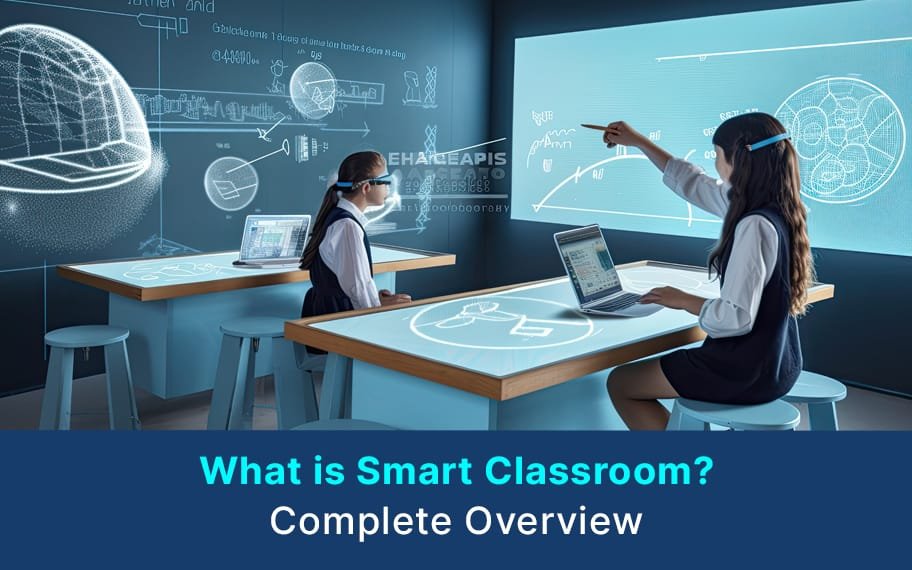
What is a Smart Classroom: Complete Overview
Description
What are the Features of Smart Classroom?
The smart classroom definition shows us it is equipped with a range of features designed to make students engage while learning, collaborate to discuss topics and personalize learning. These features of smart classrooms may include interactive displays, wireless connectivity for devices, multimedia content delivery systems, remote access to educational resources, and real-time feedback mechanisms. Additionally, smart classrooms often incorporate tools for virtual simulations, augmented reality experiences, and adaptive learning platforms to cater to diverse learning styles and preferences.
Here are some must-have elements of smart classroom for all educational institutions:
- Interactive Whiteboards: Gone are those days when teachers had to labor all day and write down everything on backboards. Now they can use an interactive whiteboard to minimize their effort in writing things and focus on maximizing learning with the diverse features of smart classroom.
- Wireless and Cloud Connectivity: Students can access educational resources, multimedia content, and online tools from their own devices. Having cloud storage is a huge plus, it acts as an online library. Teachers can also upload assignments, learning resources, and much more to ensure every study has access to the materials at every point in time. All they need is internet connectivity! The smart classroom definition itself highlights how ‘smart’ it is through such features.
- Multimedia Content: Both students and teachers can use multimedia content, simulations, and interactive activities in their lessons. This is used in all levels of learning, in kindergartens, schools, colleges, or online courses. Pictures and videos are a great way to make sure students don’t just learn but also retain information. They don’t forget what they see visually and interact with.
- Remote Access: The best elements of smart classroom are the ones that are available to students even after they go home. Through cloud-based platforms and learning management systems, students can access educational materials and assignments from anywhere. Some institutes follow a hybrid system where some classes are online and taken over learning platforms, to minimize the travel time.
- Adaptive Learning Platforms: Smart classrooms leverage adaptive learning platforms that use data analytics and artificial intelligence to personalize instruction and provide targeted support to students based on their individual learning needs and progress. Teachers can now have a different methodology for different groups in a classroom, according to their learning pace and preferences.
What are the Advantages of Smart Class?
It is as helpful to teachers as it is for students. We mostly like to point out how students benefit from it, but teachers can also work to their fullest potential with greater ease. Firstly, it promotes active learning by providing interactive and hands-on experiences that stimulate critical thinking and problem-solving skills. Secondly, smart classrooms facilitate access to a wealth of digital resources and educational content, allowing for more personalized and self-paced learning experiences.
Let's have a detailed look at the advantages of smart class:
- All-Student Engagement: Teachers have always struggled to make students interact because of how different everyone’s learning preferences are. Interactive features and multimedia content in smart classrooms captivate students’ attention and promote active participation. They are motivated to engage with its vibrant features.
- Personalized Routine and Assignments: With access to a wealth of digital resources and adaptive learning platforms, smart classrooms facilitate personalized learning experiences tailored to each student’s pace, preferences, and learning objectives. Teachers develop different routines to keep everyone engaged while keeping an eye on weak students who need more attention or different features to pick up on difficult concepts.
- Collaborative Learning: Smart classrooms allow collaboration among students through interactive activities, group projects, and online communication tools, encouraging peer-to-peer learning and knowledge sharing. When educators help students to come together, they observe each other and pick up the habits that are encouraged in an ideal learning environment.
- Data-Driven Instruction: By collecting and analyzing data on student performance and learning outcomes, smart classrooms enable educators to make informed instructional decisions, identify areas for improvement, and provide timely intervention and support. These are so far the top advantages of smart class since data is a clear measure of growth. By maintaining records, teachers can recognize which methodologies work best in a classroom.
- Updated Knowledge: Equipping students with digital literacy skills and exposure to emerging technologies in smart classrooms prepares them for the demands of the 21st-century workforce, where technology proficiency is essential for success. Educators also learn a lot from the constant use of such innovative technology. As the world grows digitally, it is impossible to imagine a future that does not use technology to make tasks easier. When students practice this from early on, they become accustomed and interested in not only learning in particular but also technology in general.
Conclusion
The advantages of smart class throw light on the significant advancement in educational technology. It offers a wide range of features to enhance teaching and learning processes. By using digital tools and resources, smart classrooms create dynamic and engaging learning environments that address all the diverse needs and preferences of students.
At Teachmint, we offer innovative learning solutions that can improve a student's progress with a holistic approach.
Short Description
What is a Smart Classroom? Educational institutions are changing with changing times. We no longer study in traditional environments where learning is limited to the classroom only. All thanks to technology! In such times, the first thing to address is what is a Smart Classroom. A smart classroom is a technologically enhanced learning environment that uses digital tools and learning resources to enhance teaching and learning experiences. It is nothing like traditional classrooms, smart classrooms have various technologies such as interactive whiteboards, tablets, projectors, and internet connectivity to create an interactive and dynamic learning space. However, our smart classroom definition is not limited to this. It depends on how every institution uses the features of a smart classroom, and how it is personalized. Let’s dive straight into its specifications!